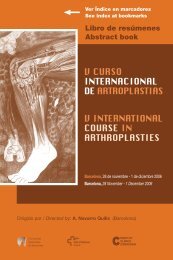Notas / Notes - Active Congress.......
Notas / Notes - Active Congress.......
Notas / Notes - Active Congress.......
You also want an ePaper? Increase the reach of your titles
YUMPU automatically turns print PDFs into web optimized ePapers that Google loves.
JUEVES / THURSDAY<br />
130<br />
minimal erosive changes in the patellofemoral articulation.<br />
Anterior knee pain, thought to be a sign of significant patellofemoral<br />
involvement, has also been an exclusion criterion.<br />
Applying these conservative indications, the percentage of<br />
patients with osteoarthritic knees who may be candidates<br />
for unicompartmental knee arthroplasty has been reported<br />
to be between 2% and 15%. In July 2004, the U.S. Food and<br />
Drug Administration approved the use of the Oxford Phase<br />
3 unicondylar prosthesis (Biomet, Warsaw, IN) for implantation<br />
in unicompartmental knee arthroplasty. Using more liberal<br />
indications, the implant has proven to be a conservative and<br />
bone preserving yet long-lasting intervention for anteromedial<br />
arthritis of the knee.<br />
The purpose of this study is to investigate the early outcomes<br />
of Oxford medial unicompartmental knee arthroplasty in<br />
patients in the United States who do not meet the standard<br />
inclusion criteria. Spe-cifically, the current study investigates<br />
the role of obesity, young age, patellofemoral arthritis, and<br />
isolated medial knee pain on the early outcomes and failures<br />
of this device. In a large series of 318 unicompartmental knee<br />
arthroplasties performed in 268 patients, these standard<br />
preoperative contraindications had no influence on the successful<br />
outcome of the procedure using the Oxford Phase<br />
3 device. The con-servative, bone preserving nature and<br />
long-term survivorship of the Oxford Phase 3 device warrant<br />
its position at the top of the list of alternatives for treating<br />
medial disease in the growing middle age population. In<br />
addition, by restoring the knee to the pre-disease state with<br />
ligamentous balance and functional kinematics, activity and<br />
lifestyle are considerably improved to near normal in many<br />
patients following this con-servative procedure.<br />
The current series supports the elimi-nation of age, weight,<br />
presence of patellofemoral joint disease, and anterior knee<br />
pain from the list of contraindications to unicompartmental<br />
knee arthroplasty when the Oxford Phase 3 device is used.<br />
SUGGESTED READING<br />
1. Kozinn SC, Scott R. Unicondylar knee arthroplasty. J Bone<br />
Joint Surg Am. 1989; 71:145-150.<br />
2. Goodfellow J, O’Connor J, Murray DW. The Oxford meniscal<br />
unicompartmental knee. J Knee Surg. 2002; 15:240-246.<br />
3. Price AJ, Waite JC, Svard U. Long-term clinical results of<br />
the medial Oxford unicompartmental knee arthroplasty. Clin<br />
Orthop Relat Res. 2005; 435:171-180.<br />
4. Vorlat P, Putzeys G, Cottenie D, et al. The Oxford unicompartmental<br />
knee prosthesis: an independent 10-year<br />
survival analysis. Knee Surg Sports Traumatol Arthrosc.<br />
2006;14:40-45.<br />
5. Price AJ, Dodd CA, Svard UG, Murray DW. Oxford medial<br />
unicompartmental knee arthroplasty in patients younger<br />
and older than 60 years of age. J Bone Joint Surg Br. 2005;<br />
87:1488-1492.<br />
6. Rajasekhar C, Das S, Smith A. Unicompartmental knee<br />
arthroplasty: 2- 12-year results in a community hospital.<br />
J Bone Joint Surg Br. 2004; 86:983-985.<br />
7. Pandit H, Jenkins C, Barker K, Dodd CA, Murray DW. The<br />
Oxford medial unicompartmental knee replacement using<br />
a minimally-invasive approach. J Bone Joint Surg Br.<br />
2006; 88:54-60.<br />
BI-COMPARTMENTAL KNEE<br />
Alois Franz<br />
Hospital for Orthopedic Surgery and Sportmedicine<br />
Marienkrankenhaus,<br />
Siegen (Germany)<br />
Total Knee Prostheses have evolved over the years to the<br />
current mechanically superior anatomic designs and thus<br />
converting Total Knee Arthroplasty into one of the most successful<br />
surgical procedures. Future success in improving TKA<br />
requires attention to the knee prostheses design but also to<br />
the patient profile and its expectations. Stratification of the<br />
patients based on different activity levels (demand) and<br />
pathologies (severity of osteoarthritis, compartmental distribution<br />
and Soft Tissue affection) must be done in order to<br />
find the best solution to relief the original symptoms and restore<br />
the normal motion of the knee. Therefore, following the<br />
same principle, stratification on the knee port-folios should<br />
also be driven in order to meet in every single pathological<br />
case its ideal solution. The Journey DEUCE is the first knee<br />
device that treats Bi-Compartmental Knee Arthritis while<br />
leaving the pristine lateral condyle intact (Bone sparing) and<br />
preserving both ACL and PCL (Soft Tissue sparing) in order<br />
to improve the proprioception.<br />
The Surgical Technique has been designed based on a<br />
Primary TKA in order to facilitate as much as possible the<br />
procedure. On the tibial side, the medial tibial plateau is<br />
resected with the aid of an Extramedullary Alignment System.<br />
On the femoral preparation first the IM canal is opened. The<br />
Whiteside line or/and Epicondylar lines can be marked to act<br />
as landmarks for the positioning of the anterior cutting block<br />
and the determination of the external rotation. After the release<br />
of the anterior cutting block, the transition point has to be<br />
marked. This is the most distal part of the lateral condyle<br />
(where the resection meets the lateral cartilage). This point<br />
acts as reference for the positioning of the Distal Cutting Block<br />
system (for its varus/valgus position). After having re-sected<br />
the medial distal condyle, a 3-in-1 cutting block (anterior<br />
chamfer, posterior chamfer and posterior condyle cuts) has<br />
to be placed against the distal and anterior cuts of the femur.<br />
Once all the cuts are done, the Trial Reduction can be<br />
performed. If the desired stability has been achieved, the peg<br />
holes of both femur and tibia are performed.





